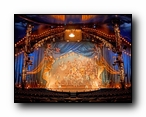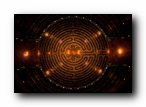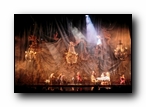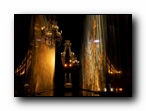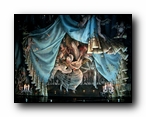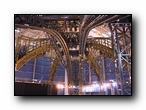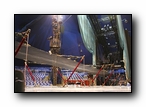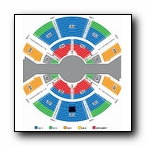
![]()
[ You are here: Grand Chapiteau | Creations | Corteo | Scénographie ]
Création
Expérience
Réserve RetiréOdyssey
The set and décor of Corteo plunge the audience into a lyrical world, a strange area between heaven and earth. Set Designer Jean Rabasse has divided the Grand Chapiteau and its rotating stage in two, with each half of the audience facing the other half, so they see not only the performance, but also have a performer’s-eye-view of the audience. Thus the stage becomes a 41-foot (12.5 m) long track upon which performers run from one side to the other, rather than being out in the round. This is a first for Cirque du Soleil.
Corteo vividly portrays the funeral of a circus clown as a festive parade with a carnival-like atmosphere. Processions - on stage and careening above it - are woven throughout the story, a theme that prompted placement of an elongated open stage down the middle of the oval "Grand Chapiteau" tent. The resulting split auditorium - with two facing audiences of about 1,000 each - dictated dual mirror-image audio systems. The task was assigned to veteran sound designer Jonathan Deans, and his response to the challenge was a technological tour-de-force comprising 38 self-powered Meyer Sound loudspeakers per side with mixing and control from a common LCS Audio CueConsole. "I simply could not have accomplished my design for Corteo without the LCS console and the Meyer Sound loudspeakers," Deans maintains. "There are too many distinctive elements to the sound in Corteo that would have been impossible to duplicate using a conventional console and passive loudspeakers." Deans acknowledges that the simplest approach to covering the wide, shallow seating areas would have been using conventional clusters mounted on the near side masts. But the resulting angles would have raised the image too high off the stage, so he opted instead to lower the image angle by covering most of the mirror-image auditoriums from the opposite side masts. To maintain precision-directed sound despite the longer throw, he specified four M1D compact curvilinear arrays of six cabinets each as the keystone elements of the system. "The M1Ds worked incredibly well," Deans says. "Using MAPP Online Pro (acoustical prediction software) we were able to aim the arrays precisely to miss the stage and the band pits at the four corners of the stage. We covered most of the seating uniformly, yet cut off right at the last row so we didn't hit the reflective low canvas at the back." Corteo marked the first time Deans had specified M1D arrays for a show, and the results immediately influenced his thinking about main FOH clusters. "I've put them in three new shows already," he remarks, "and a fourth show is coming soon. The M1D is an incredibly high- powered system for such a small footprint, and the fidelity is truly astonishing." With the M1D arrays positioned to miss the musicians and the stage, and with support masts casting acoustical shadows, Deans filled in the coverage with various other Meyer Sound products, including CQ-2 narrow coverage main, UPA-2P compact narrow coverage, and UPM-1P ultra-compact wide coverage loudspeakers. A dozen UPJ-1P compact VariO loudspeakers serve as surrounds, with four more affixed to the masts to take over vocal reproduction whenever "hot-mic'ed" acrobats fly up into the crossfire of the M1D arrays. Deep bass comes from four PSW-2 high-power flyable subwoofers. The self-powered Meyer Sound loudspeakers are fed from an LCS Audio Matrix3 digital audio system, which takes care of all mixing, signal processing and output matrixing chores. Matrix3 gives Corteo precise, automated cue-based mixing capabilities, integrated into a highly customizable and robust system. Configured with six LX-300 digital audio engines at its heart, the show's Matrix3 boasts 80 analog inputs, 64 analog outputs, parametric equalization, dynamics, matrix routing, and custom multichannel surround sound using SpaceMap, the Matrix3's standard software panning tool. Deans finds the system's extreme flexibility essential to the sound design for Corteo. "In Corteo, the sound has to change depending on your angle to the visual," he explains. "That goes back to the need for the LCS system. With both near side and far side to consider on every cue, you have a far greater need for individual inputs and outputs to feed various sets of discrete speakers." Performances of Corteo are mixed from CueConsole, LCS Audio's modular collection of tactile control surfaces for the Matrix3. The CueConsole residing at the show's FOH position consists of three 16-channel Fader modules, two 16-channel Meters modules, and one each of the Transporter and Editor modules. CueConsole's modularity merely scratches the surface of its configurability: faders and buttons on CueConsole modules can be assigned to control any parameter at any time in any cue, and even redefined on the fly. Further, CueConsole modules are clients in the Matrix3's client-server architecture, allowing several of the sound operators for Corteo to mix and save cues simultaneously from anywhere in the Grand Chapiteau using wireless connections from their laptops. While CueConsole is in use at three resident Las Vegas Cirque du Soleil shows ("O", Zumanity and KÀ), Corteo marks its first use in a touring Cirque production. |


